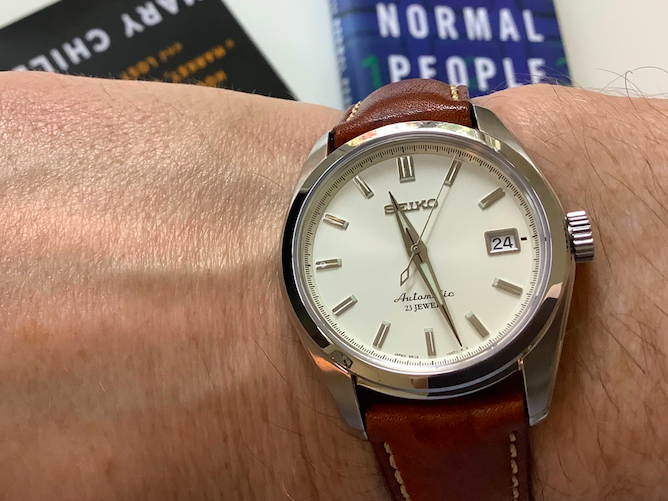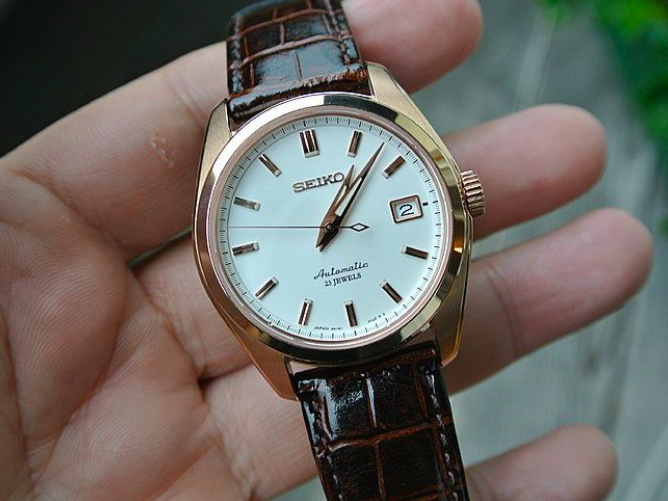The imperfect perfection of the SARB
Simplicity is the most difficult thing to secure in this world; it is the last limit of experience and the last effort of genius. - George Sand
SARB035 on Perlon
I have two Seiko sport watches, mirror images of one another: the dark-dialed SARB033 and the cream-dialed SARB035. Introduced in 2008, they were produced solely for the Japanese domestic market, and only gradually found their way into western collections, where they became legends among watch enthusiasts.
There’s nothing special about them, exactly. They are simple and good mechanical watches with classic mid-century styling cures. At their original price of around $300 they represented very good value , but not a high degree of luxury or prestige. And yet they inspire strong loyalty among the people who own them.
Seiko discontinued the line in 2018. But in his 2022 review of the best Seikos (linked below), Teddy Baldessarre conceded that the SARBs still compete effectively with their successors:
These two watches are probably the most talked about when answering questions of the best pieces for around $500. And although I have become a bit fatigued with them, there is no question of their greatness for the money. With their extremely wearable cases, attractive/versatile looks, ability to be paired with a variety of straps, capable specs, and most importantly, great prices, these models are still some of the best value you can find in all of watchmaking.
In a 2020 Youtube video (linked below), The Urban Gentry ascribed the appeal of the SARBs to five factors:
Size. A SARB comes in at a neat 38 mm case diameter, a bit bigger than a vintage Rolex, but smaller than most modern sport watches. At just 11 mm tall, it doesn’t distract the way a big dive watch might. It slides smoothly under the cuff of a dress shirt. It works with you, stays out of the way when you don’t need it. “It feels like a classic watch should wear,” says Urban Gentry.
Quality. Very good - and for the original price point, absurd. Urban Gentry notes that “it is extremely well-finished,” with polishing comparable to watches costing many times more.
Design. The SARB has no direct lineage, although it owes many of its styling cues to the King Seiko models produced in the 1960s and early 1970s..
King Seiko Hi Beat 5625-7000, ca. 1969 (Image Source)
The dauphin hands and needle second hand, the bordered date window, and the restrained typography create an impression of relaxed sophistication. This is hard to get in a watch. The creative pressure in watchmaking is to differentiate, define your identity.
Prestige watches in particular need an angle to justify their premium price. An up-market Grand Seiko might come with a backstory, exotic materials, a unique movement, and perhaps specialized manufacturing techniques to give each piece a distinctive identity.
The creators of the SARB were sheltered from all this. They didn’t need to make something novel, they we allowed to make something good. Mass market watch designers so often miss the opportunity, but in this case, they managed to create something beautiful, balanced, and harmonious, that almost anyone can afford.
So what is it? The Urban Gentry says, “it’s not a true dress watch, it’s not a true sports watch - it’s almost the perfect hybrid.” While often compared to the Rolex Datejust, the SARB accepts a more limited role, which again protects it from the risk of overreach. One selling point of the Datejust is that it is a durable and precise universal companion, as much at home in the Antarctic as the boardroom. If I were a CEO with a penchant for expeditions, I would certainly get one. The SARB is not this. It is a timepiece for civilized people going about their business. in this role, few watches can better it.
SARB033 on leather (Image Source)
Performance. The SARB has good mid-range features, including a sapphire crystal, a 23-jewel mechanical movement with hacking, and a Hardlex display back. But this should not be overstated. While the aesthetics of a SARB compare favorably with more expensive watches, it has a relatively basic movement. My Seikos vary a bit, gaining or losing noticeably over a week of wear. I don’t mind. For those who do, a Rolex or Jaeger-LeCoultre will perform much better, for a price.
Value. Today, old SARBs sell for 150-200% of their original selling price. This week I saw a rare SARB037 - identical to these, but with a rose-colored dial - listed for $1,800. But even at these prices, they represent good value for those who place more emphasis on aesthetics than perfect accuracy.
SARB035 on on leather
The classical styling means that the SARBs seem to go well with almost any strap or bracelet. Like an actress who can wear anything and look good, they present well on leather, alligator, ostrich, even Perlon. Strap makers often use them as models for their wares:
Some would argue that Seiko miscalculated with the SARB. The watch was simply too good for the price point, and its popularity in the mid-range makes it difficult to move it up-market. Not that no one has tried. Some of Carl F. Bucherer’s Manero models capture the SARB aesthetic with better materials and premium ETA movements, stopping just short of outright imitation:
Carl F. Bucherer Manero (Image source)
I’ve wondered why Seiko doesn’t simply embrace the SARB aesthetic and produce a premium version. Why not have a platinum one with Spring Drive? Seiko has tried it, a little bit. The SARB070 and SARB072 are basically the original design in gold trim. But the effect is disappointing, somehow, and these models were discontinued.
SARB072 (Image Source)
So we learn that the SARB aesthetic is surprisingly fragile. These watches represent a sublime balance of styling and materials, form and function. But it is such a delicate balance that any attempt to improve it just makes it worse. It turns out we must accept the SARB033 and SARB035 for what they are: perfect.
Links





